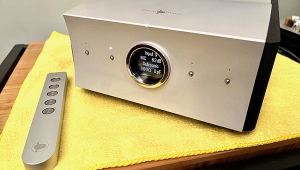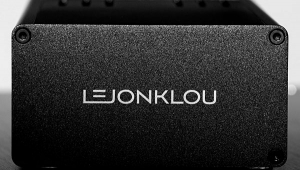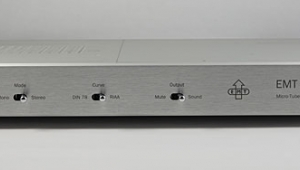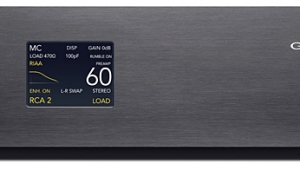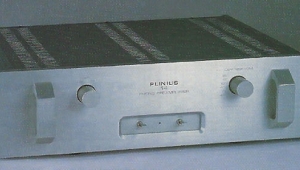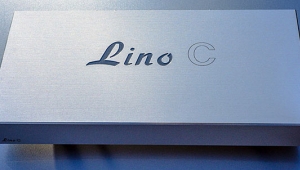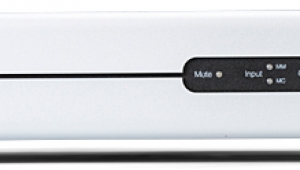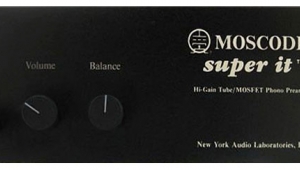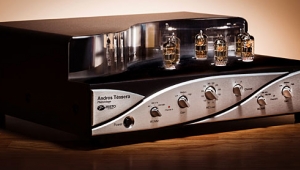| Columns Retired Columns & Blogs |
Vendetta Research SCP-2 phono preamplifier
Few people in the audio business would deny that John Curl is an audio design genius—arguably the greatest one of our generation. He designed and built the electronics for Mobile Fidelity's SuperMaster and David Wilson's (of Wilson Audio) UltraMaster tape recorders, two of the three best analog recorders in the world. (The other is Keith Johnson's home-brew unit.) He designed the JC-1 head amp and JC-2 preamplifier sold under the Mark Levinson name some years ago. He designed head amps for SOTA, Michaelson & Austin (TVA), and has done consulting work for more high-end companies than you can shake a stick at.
Footnote 1: Since the early 1990s, John Curl has been designing amplifiers for San Francisco-based Parasound. You can find Curl's biography on their website.—John Atkinson
Yet, for all his acknowledged design brilliance, fame has not brought John Curl fortune—like so many geniuses, he has earned a reputation for being hard to deal with. It's not that he drives a hard business bargain; quite the opposite, in fact. He has been cheated, defrauded, and ripped off by some of the best-known names in audio. His "problem," as seen by his clients, is that he an idealist of the first order, with strongly held ideas of how things should be done: ie, as well as possible and hang the cost. In the pursuit of audio perfection, Curl little comprehends the meaning of "compromise." His designs tend to be truly no-holds-barred, using the best components money can buy to produce the best sound and highest reliability the state of the art allows.
This approach is all well and good when cost is, in fact, no object—when the goal is to design the best tape recorder in the world—but it is not a formula for success in a competitive consumer market where price is as important as quality, if not more so. Consequently, almost every design he has developed for clients has been modified to make it "more affordable" or, in some cases, to make it just different enough that it could be used without reimbursing him for his efforts.
Finally, in 1981, fed up with the restrictions that consulting work placed on his designs, Curl founded Vendetta Research to produce his own products. (The inspiration for the name? "I'll show the bastards!") Vendetta's best-known product was the TCP-1 phase-coherent electronic crossover, but the firm never really took off because it was never promoted. Most audiophiles, including those who've heard of John Curl, don't even know Vendetta Research exists. Now that you've read this, you have no such excuse (footnote 1).
Vendetta's newest product, the SCP-2 preamplifier, is typical of the JC design approach. To begin with, while it is a preamplifier, it is not a control preamplifier. The SCP-2 accepts the output from a MC cartridge and delivers an RIAA-equalized output at line level; ie, suitable for feeding a power amplifier. Second, it inverts polarity, at a time in audio history when this is not considered a good thing. (The instructions call attention to this and suggest that it be "taken into account when making comparisons," as though this was always possible.) Third, at $1895, it is the most expensive stand-alone solid-state phono-preamplifier on the market. And fourth, it is not just a dual-mono unit, it is actually two completely separate—physically as well as electrically—mono units. (Curl explains that that's what Japanese consumers wanted, and he targeted them first because they are less price-conscious than Americans.) The two channels are, however, available on request in a special frame that ties the two units together side by side in a rack-mount adaptor.
Normally, each channel of an SCP-2 comes in two pieces: the preamp itself, attractively finished with walnut end panels, and a separate power supply, the SCP-1. This contains an Avel-Lindberg 30VA toroidal transformer and delivers regulated plus and minus DC rails to the SCP-2 via a 6' umbilical cord.
Construction is to a very high standard, the circuitry for each channel being carried on two gold-plated, double-sided printed circuit boards. Close-tolerance resistors and Rel-Cap polypropylene-dielectric capacitors are used throughout, and socketry is by Tiffany. Cartridge loading is adjustable from 10 to 200 ohms by means of an internal potentiometer, which means the adjustment can be done while listening—an unusual feature offering a distinct advantage over the typical plug-in resistor arrangement. On the other hand, if you prefer just to set the loading to the cartridge manufacturer's recommendation, you can do that, too, but you'll need an ohmmeter; there are no resistance calibrations on the pot. Either way, the only potential hitch is that the loading pot is accessible only by removing the SCP-2's top panel, which requires the use of a smaller Phillips-head screwdriver than many hobbyists are likely to own.
The SCP-2's symmetrical cascode input stage uses DC-coupled complementary FETs that act as a single stage. The HF part of the RIAA playback equalization is passive, and there is no feedback around the first stage, but some can be added if desired to reduce the input impedance to below 10 ohms minimum. The second stage consists of complementary symmetrical FETs, around which negative feedback is used for the LF portion of the RIAA EQ. Each stage has its own FET power-supply buffer for minimum noise and intrastage interaction. A high-quality op-amp is used to provide a DC-servo for each stage.
Footnote 1: Since the early 1990s, John Curl has been designing amplifiers for San Francisco-based Parasound. You can find Curl's biography on their website.—John Atkinson
- Log in or register to post comments
